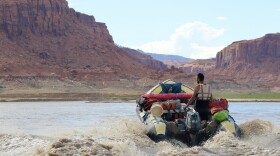
Luke Runyon
Managing Editor & Reporter, Colorado River BasinAs KUNC’s managing editor and reporter covering the Colorado River Basin, I dig into stories that show how water issues can both unite and divide communities throughout the Western U.S. I edit and produce stories for KUNC and a network of public media stations in Colorado, Utah, Wyoming, New Mexico, Arizona, California and Nevada.
In 2021 I was a Ted Scripps fellow at the University of Colorado's Center for Environmental Journalism. Before covering water at KUNC I covered the agriculture and food beat for five years as the station’s Harvest Public Media reporter. I’ve also reported for Aspen Public Radio in Aspen, Colo. and Illinois Public Radio in Springfield, Ill. My reports have been featured on NPR's Morning Edition, All Things Considered, Weekend Edition, Here & Now and APM's Marketplace. I’m a proud graduate of the University of Illinois’ Public Affairs Reporting program.
My work has been recognized by the Society of Environmental Journalists, Radio Television Digital ���ڱ��� Association, the Colorado Broadcasters Association and the Public Media Journalists Association.
When I’m not at the station you can usually find me out exploring the Rocky Mountains with either a pack on my back or skis on my feet.
-
Leaders from three states along the shrinking Colorado River say they are ready to start taking less water from it. In a proposal announced Monday, water users and policymakers in California, Arizona and Nevada committed to reducing their take of the river until the end of 2026, when an existing set of management rules expires.
-
The White House and seven Western states have agreed to a framework for sharing the Colorado River's water. The deal directly impacts 40 million people who rely on the river for water and power.
-
Lake Powell is a boater’s dream. The nation’s second largest reservoir on the Colorado River is a maze of sandstone canyons teeming with houseboats. But climate change and unchecked demand for water sent the lake’s levels to a new record low this year. In this episode we explore changes to recreation in this popular vacation hotspot.
-
Farmers and ranchers use the vast majority of the Colorado River’s water. Getting them to voluntarily use less is difficult.
-
The Colorado River’s current crisis traces its roots back to 1922. That’s when leaders from the rapidly-growing southwestern states that rely on the river traveled to a swanky Santa Fe mountain retreat to divvy up the river’s water. Growing populations in some of the West’s burgeoning cities and sprawling farmlands, and the anxieties tied to that growth, pushed leaders to the negotiating table.
-
Cuts to water use along the Colorado River could be spread evenly across some southwestern states, or follow the more than a century-old priority system that currently governs water management. Those are two alternatives federal officials are considering to keep hydropower generation going at the nation’s largest reservoirs according to a draft plan released Tuesday.
-
Thirst Gap is a six-part podcast series about how the Southwest is adapting to water shortages as climate change causes the region to warm up and dry out.
-
The law that divides the Colorado River between seven states is turning 100, and it's being strained beyond what its drafters could have imagined.
-
The Colorado River's foundational agreement is 100 years old this month. And while the document among seven western states was groundbreaking for its time, it's currently left the southwest to grapple with a massive gap between water supply and demand.
-
A Nevada water agency has taken the first concrete step toward accounting for evaporation and other losses in the Colorado River’s Lower Basin. The new analysis attempts to pinpoint exactly how much water is lost, and who should cut back to bring the system closer to a balance between supply and demand.









